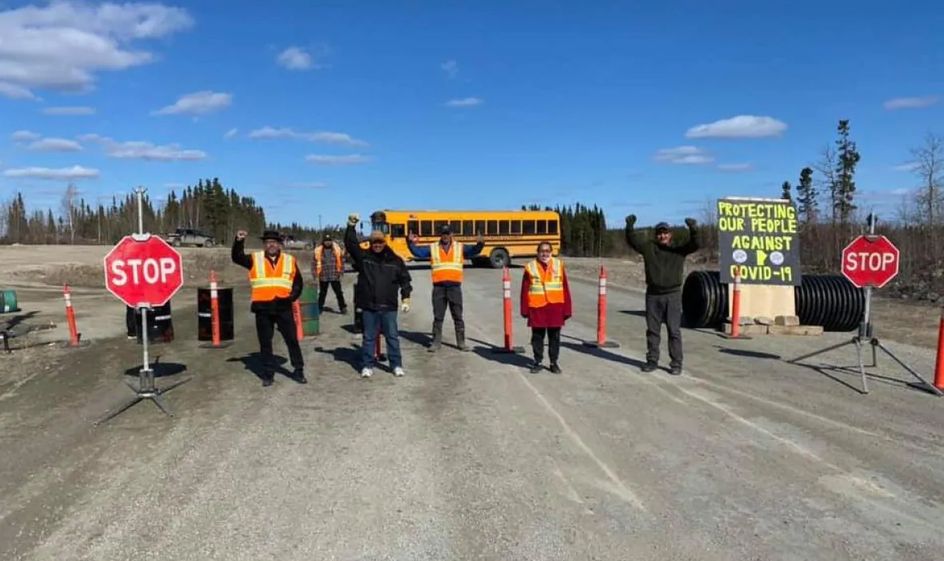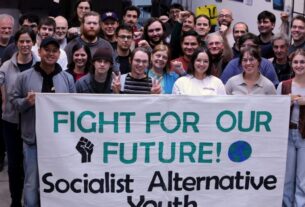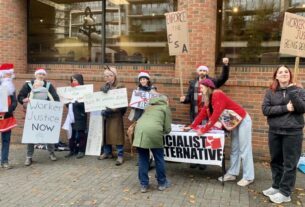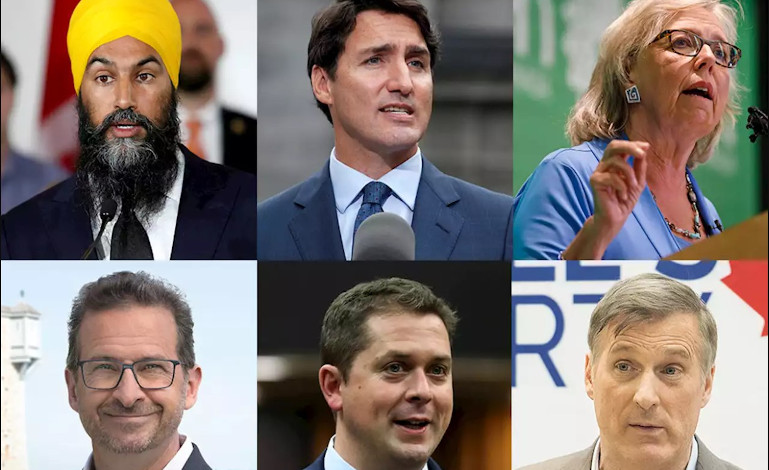On December 14, the first COVID vaccinations were given in Canada. This gave hope that there may be an end in sight, in this dark winter. Politicians were keen to highlight the vaccine, less enthusiastic in addressing the current reality.
COVID is largely out of control across much of Canada. November and the first half of December have seen record daily new cases nationally, and in every province and territory except PEI, Newfoundland and Nova Scotia. Seniors’ care homes are again becoming death camps. The death rates are not as high overall as in the spring, due to lower rates in Ontario and Québec, but in the four western province things are much worse. It is likely in the next months deaths will surge; doctors and hospitals are warning of a winter crisis.
Most worrying, the rate of new cases is at an all time high. Since November, as a result of action in the territories and the western provinces, the rate of increase has slowed, but only compared to peak; the number of cases is still far higher than in the spring. The rates in Ontario and Québec are still increasing. Alberta’s rate of increase remains among the worst in the world.
In June and July, the four Atlantic provinces, in their bubble, had virtually no cases. In October and November cases increased and the bubble ended, but things are still relatively under control. Ontario and Québec, where COVID was never under control, politicians have continued their confused zig-zags and reluctance to close down businesses and now are faced with hospital overload. On December 21, Doug Ford announced a province wide lockdown, starting December 26. Manitoba and Saskatchewan had very low case loads in the spring and summer. In the autumn, cases soared and politicians were very slow to act, driven by their right-wing ideology. The northern regions and the three territories were largely free of COVID in spring and summer but now cases are creeping in, spreading real fear in these communities, many of them isolated Indigenous communities with few health facilities. So far, only three people have died in the territories. BC was seen to have acted well in the spring, but, like others, the government was complacent over the summer and now cases are at a dangerously high level. Alberta, with Canada’s most ideologically conservative government, criminally dragged its feet on any action.
Not Prepared for Second Wave
It was well known that a second wave was coming, as none of the larger provinces made any attempt to eradicate the virus. This was like firefighters getting a blaze under control and leaving while the embers were still smouldering – inevitably the flames would re-erupt.
Disgracefully, once the figures were low, everything re-opened. Manitoba, for instance, ran an advertising campaign inviting people to come for a vacation. If instead, when cases were low, action had continued to eradicate COVID, a second wave could have been avoided. On September 11, there were no recorded COVID deaths in Canada, the first day of no deaths since March. Since then, a further 5,200 people have died – all avoidable deaths.
There was no preparation for the second wave. It might be argued, albeit without much force, that Canada’s governments could not have foreseen the first outbreak of a pandemic. Everyone knew wave two was coming as the virus had not been extinguished.
In the summer Canada’s government, working with the provinces, should have thoroughly prepared. This would have included a program to prepare large numbers of test kits, mass production of PPE, and establish rigorous testing and tracing systems and comprehensive isolation measures. Alongside strong public health programs, social and economic policies needed to be in place including ending homelessness and universal paid sick leave. All long-term care homes should have been brought into the public sector with full staffing on decent wages.
A pathetic excuse is the federal structure of Canada with health a provincial responsibility. However, if the Canadian government had offered all provinces and territories a gold standard COVID response system, the pressure would have been immense on any provincial politicians who preferred to go with a sub-standard approach.
Most students, parents and teachers agree that schools should be open, but open safely. Governments across the country took risks re-opening on the cheap. As of December 21, 6,388 schools in Canada had had at least one case. Class sizes have not been reduced to a maximum of 15 students to allow distancing. A classroom is the size of a small store, yet stores are operating with very limited number of customers, some only allowing three or four at a time, while classes can have up to 30 students! Circulation of aerosols of COVID is a concern so it is recommended to have good air flow – yet many school boards’ only action is to recommend opening windows, in a Canadian winter!
Test, Trace and Protect
Across Canada there have been repeated shortages or restrictions for tests, and test results often take days. This is not due to the limits of science, it is governments acting on the cheap.
Professional sports teams, operating in bubbles cut off from wider society, get regular fast tests. In July, basketball players, in a Florida bubble, were getting daily or every-other-day testing and the results come back in 12 to 15 hours.
In November, registered nurses in Los Angeles protested because the UCLA’s athletic department conducted 1,248 tests in a single week while health care workers at UCLA hospitals were denied testing. The US National Nurses United, the country’s largest nursing union, surveyed over 15,000 members and found that around two-thirds had never been tested. In the first wave, health workers were not protected. According to the Canadian Federation of Nurses Union, “Health care worker infections in Canada were twice the global average during the first wave of COVID-19.” This shows the priorities of big business and government. Professional sports teams are more important than front line health workers.
Private tests are available for $300 – $400 dollars. These labs should be brought under public control with the capacity used to test priority workers. People’s health should come before the profiteers of illness and fear.
There have been reports of shortages of swabs for tests – leading to delays across Canada. Surely in April and May the Canadian government could have launched programs to mass produce swabs, test kits. etc.
CBC reporter, Lorenda Reddekopp, reported that recently Toronto did not know where 70 percent of cases were coming from – its tracing system was hardly working. PEI had a big backlog of unprocessed tests in early December. In late November, Saskatchewan’s tracing system was “strained” with many cases untraced or unknown. Alberta gave up trying to trace over 3,000 cases due to its backlog. There are still reports of PPE shortages.
Some seven million people have entered Canada since March. While half are truckers and many are returning Canadians, over five million of the seven million have not quarantined. In other countries every person entering is put into quarantine. With hundreds of closed and empty hotels it would be simple to enforce isolation.
The Canadian government has failed to produce adequate supplies of tests, swabs and PPE and build robust tracing networks. Complacency seems to be a factor, but a loyalty to capitalism is a major cause. They refused to command and commandeer facilities to produce equipment. Also there has been a huge emphasis on developing vaccines, where there are huge potential profits, to the detriment of the basic public health actions of testing, tracing, isolating and PPE.
Blame
As governments failed to eradicate COVID when figures were low in the summer, did not prepare for the second wave, and were slow to respond to the growing wave, they needed scapegoats to distract from their failings. Politicians have urged people to take “personal responsibility” because governments are unwilling to take government responsibility.
The blaming has been both blatant and hinted at. Two groups have become regular targets – young people and the South Asian community. Politicians have highlighted the high number of cases in Brampton in Ontario, North East Calgary and the Fraser Valley in BC, all areas with high South Asian populations, with comments about Diwali and large weddings. Both Brampton and NE Calgary are near the main airport and at the junction of major highways. They are centres of warehouses and distribution centres from where essential goods are dispatched. The largest employment sectors in Brampton are transportation, manufacture, retail and healthcare, all essential services where working from home is impossible and even physically distancing at work is difficult. The Fraser Valley has a large number of workers in transportation and distribution. These workers keep us fed and serviced and then, disgracefully, get blamed.
Young people have been blamed for socializing and being irresponsible. A survey by the BC Centre for Disease Control casts light on the reality (http://www.bccdc.ca/health-info/diseases-conditions/covid-19/covid-19-survey). Only 38 percent of people between 19 – 29 were able to physically distance at work while for all other ages it was around or above 50 percent. Similarly, young people are the least able to work remotely. Young people have the worst mental health outcomes, most likely to feel stressed and out of control, most concerned about food security, income and housing. Many young people work in essential services, yet they get demonized.
Quebec produces data on sources of infection (https://www.quebec.ca/sante/problemes-de-sante/a-z/coronavirus-2019/situation-coronavirus-quebec/#c75433). The seven-day average up to December 21 lists the sources as: workplaces 42 percent, schools 26 percent, care homes 22 percent and everything else 10 percent. So much for socializing being a major spreader. Work is the major spreader, but politicians will not act on this.
It is easy for well-heeled politicians, senior civil servants and newspaper editors to isolate and work at home in their big houses. Low-income people are least able to physically distance at work, get sick leave and work remotely, most worried about food security, finances and housing. They are the ones doing the essential work, keeping Canada going, and yet they get criticized and blamed.
Comorbidities to Blame
Another variant on the blame game is to cite comorbidities of those who have died, to deflect from government inaction. In November, Alberta started reporting the comorbidities of those who have died from COVID. Comorbidities are pre-existing chronic medical conditions. However, this is both dangerous and misleading and is a blatant attempt to blame those who have died, rather than the system that allowed them to die. These comorbidities include fairly common conditions, such as high blood pressure, which affects a substantial portion of the adult population. This practice has been controversial within the medical community and even among mainstream politicians. Prime Minister Justin Trudeau accused Opposition politicians of using comorbidities as a way of “downplaying” deaths, like a Lethbridge MP who shared an article saying only 10 “otherwise healthy” people have died of COVID-19.
COVID Lie: “All in this Together”
The least that the well-off politicians could do in COVID is show essential workers respect and treat those laid off due to COVID well. However, the class differences in Canada are more stark with COVID. The poor and working class are most likely to get ill and die and suffer the worst financial impacts. Indigenous people are now facing terror in northern communities. Women have been hit hard by job losses and the lack of childcare.
The government’s allocation of money shows the class divide. CERB was supposed to help people through COVID and people were encouraged to apply. In April, Ottawa recommended that provinces should not claw back CERB from people on benefits. Only BC, Yukon and North West Territories have done so. Outrageously, all the rest of the provinces are clawing back all or some of people’s existing benefits, causing real hardship. As a result, people have lost all their benefits and some have been made homeless. Now Ottawa is coming for CERB recipients. At least 441,000 letters have been sent out telling people to pay back over $10,000. People may lose their homes or their businesses. Trudeau said, “I don’t want people to worry over Christmas.” Easy for him to say, living in a big house on big income.
No such letters have been sent to the many corporations that claimed the Canada Emergency Wage Subsidy (CEWS) and used it to pay out higher dividends. CEWS, which was supposed to help companies keep on staff, will cost taxpayers some $100 billion by the end of 2021. The CBC has highlighted companies that boosted their revenues during COVID yet claimed CEWS. Thirty companies boosted payouts to shareholders by $2 billion this year and claimed CEWS. Some also bought back shares and some fired workers. Only on December 22 did the government produce a list of the organizations that received money, including a neo-nazi group, but not the amounts received and it has not produced an audit of how it was used. One beneficiary is the Royal Ottawa Golf Club, an elite course used by senior politicians and top bureaucrats, that got over $1 million and now has a large surplus and is in a “very strong financial position.”
Significantly, Extendicare, a Markham, Ontario publicly-traded company which operates over 100 care facilities for seniors across Canada, is near the top of the list in receiving CEWS. It also paid dividends of over $21 million to its shareholders. Across the country, various Extendicare facilities have experienced significant COVID outbreaks and deaths including Extendicare Guildwood in Scarborough, Ontario where a quarter of its residents died from COVID-19. Michael Guerrierre, Extendicare’s CEO received a salary of $2,091,140 this year. Extendicare also reports in the third quarter of 2020, that “Revenue [is] up 10.1% or $27.2 million to $296.8 million; driven by COVID-19 funding of $28.7 million, LTC funding enhancements and growth in retirement living and other operations, partially offset by a 9.9% decline in home health care average daily volumes (ADV).” Chartwell Retirement Residences is another business on the list of those who received CEWS and distributed dividends. As always, one law for the rich and one law for the rest of us.
Vaccine
The development of multiple vaccines in a year is an amazing scientific and technical achievement. However, due to the rapid move from research to production there are unknowns such as how long immunity lasts, what the side effects are, and will the vaccines deal with new cornovirus mutations.
There is big money to be made by the drug companies from these vaccines. Much of the basic research was done or paid for by the public sector, but the profits will go to the companies. Another area for concern is that most of Canada’s prescription drugs, or their components, are made in India and China. Canada had a publicly owned laboratory that made vaccines – the Connaught Labs, but Prime Minister Mulroney privatized it in 1986. It is now owned by Sanofi and is making vaccines for diphtheria, tetanus and whooping cough.
The arrival of a vaccine has been the focus of Canada’s government, until then not eradicating COVID, but trying to contain it at a level that does not overwhelm the health system.
Cruel Approach
A few countries have controlled COVID. For example, Mongolia, Taiwan, Vietnam and Cuba, with wide variations in governments, have a total population of 135 million and have had only 181 deaths in total from COVID. In Canada, with its population of 37.5 million, an average of 111 people have died every day between December 8 and 21.
The policy of waiting for a vaccine is cruel and fatal. On top of the unnecessary deaths is the enormous pain, stress and worry for millions. Health and care workers are exhausted and face many more months of hard work. Many other workers have lost their jobs or are stretched and stressed including in education and in all of the food supply system. Mental health has fallen sharply.
The excuse was not to damage the economy yet allowing COVID to flare up again has inflicted huge damage on the economy, living standards, jobs and government spending. It was a short-sighted policy with disastrous consequences.
The human suffering is unnecessary. A socialist government would take emergency action to:
- Immediately bring all long-term care homes and private testing labs into public ownership
- Launch a rapid program to develop and mass produce safe tests and PPE
- Invest in education, hiring more staff, installing air filters and taking over unused buildings such as gyms and hotels to allow smaller class sizes
- House the homeless and overcrowded in hotels
- Introduce paid sick leave for all workers
- Rapidly expand public childcare
- Ensure workers have the full right to refuse unsafe working conditions, without victimization
- Prosecute the worst of employers, who endanger workers and the community
- End harassment of CERB recipients
- Restrict CEWS payments for hiring staff, not paying dividends to shareholders
- Re-install a ban on rental evictions
Unfortunately, Canada does not have a socialist government so we have to suffer the ruling class’ incompetence. Socialist Alternative Canada is working for a socialist future. If you agree with us, join us.




